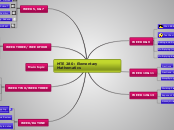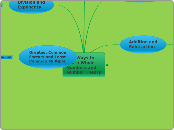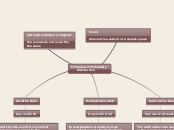MTE 280: Elementary Mathematics
WEEK 12 & 13
MWW (Milten's Wise Words)
Never teach a kid a trick/short cut without knowing how it works... because you will not be able to answer students questions
Think about the #'s you will use in a problem ahead of time to avoid possible mistakes and identify problem students may come across
Exponent Rules
same base= multiply numbers and add exponents
Dividing Fractions
Why do we need to find common denominators when adding/subtracting fractions?
To make sure we add/subtract the same size pieces
1 1
--- (division sign) ---
2 3
half into groups of one third
start with one half and you ad one third to the one half piece. The end result of this will be one and a half groups. *look at notes*
WEEK 10 & 11
Simplifying Fractions
Break it up and find the ones
4 2(2) 2
---- = ---------- = ------
10 2(5) 5
these two's = one so you are left with 2/5
36 6(6) 6 2(3) 3
---- = ------- = ---- = ------- = -----
24 6(4) 4 2(2) 2
4x^2y 2(2)(x)(x)(y) 2(x) x
--------- = ---------------- = -------- = -----
8xy^2 2(4)(x)(y)(y) 2(2)(y) 2y
x^3 x x x 1
------ = ------------------------------ = -------
x^14 x x x x x x x x x x x x x x x^11
x^4 x x x x
------ = --------- = 1
x^4 x x x x
x^2
x^1 = ------- = x^2-1 = x^1
x
Fractions (+/-)
*+/- combine pieces with same size that is why we need to find common denominators
2 1 5 2
--- + --- ---- ---> -----
15 3 5 15
*Multiply by 5 over 5 to get the same size pieces in order to add them
Fractions
Ways to demonstrate fractions...
-Pie charts
-Number line
-Geo board
-Fraction tiles
WEEK 8 & 9
Multiplying Biomials
AREA METHOD
(x+2)(x+3)
x + 3
x x^2 | 3x
+----------------
2 2x | 6
x^2+5x+6
*() rep a # a group
*order it w/ variables & constant last
(x-3)(x+1)
x - 3
x x^2 | -3x
+---------------------
1 x | -3
x^2-2x-3
(x+2)(x^2+5x+3)
x^2 + 5x + 3
x x^3 | 5x^2 | 3x
+-------------------------------------
2 2x^2 | 10x | 6
x^3+7x^2+13x+6
DIAMOND METHOD
*turns trinomials into biomials
-Refer back to notes-
Multiplying (+/-)
3(4) 3 groups of 4
(++++) (++++) (++++)
3(-4) 3 groups of 4 neg.
(- - - -) (- - - -) (- - - -)
-2(4) take away 2 groups of 4 pos.
|+ + + +| |+ + + +| + +
- - - - - - - - - -
* because we start off with taking something away without having anything we just draw lots of zero banks (+/-) and take away afterwards in order to show our answer
-1(3)
|+ + +| + +
- - - - -
-3(-2)
|+ +| |+ +| |+ +|
- - - - - -
*students who have a better understanding of will draw exactly what they need
Why is a -47 and a -20 a pos.?
taking away 47 groups of 30 neg. which leaves you with pos.
Adding and Subtracting (-/+)
(-3)+(-1)
- - - -
(-4)+3
+ + +
- - - -
(-1)+5
+ + + + +
-
(-4)-2
---- --
Test Review
FALL BREAK
WEEK/DAY ONE
Bizz Buzz Game
Say bizz on numbers that have a 7 in like 7, 27, 97... AND any multiples of 7 such as 7, 14, 21, 28...
Say buzz on any numbers that are multiples of 11. 11, 22, 33,...121...
Cornell Style notes
Syllabus Review
Juggling
Model: Show students what to do and how to do it be explaining technice
PRACTICE PRACTICE PRACTICE!
Students will never understand why you do what you do unless they practice.
WEEK TWO/WEEK THREE
Pick numbers wisely! Need to pick numbers to make discussing about math problems easy and have every one on the same page.
Methods on How to Math
ADDITION
-Left to Right Partial Sums: allows students understand and recognize the value of numbers.
-Latus Addition: use crazy boxes and add diagonally.
-Scratch: scratch each number when there is a ten involved. In the end count the scratches to count how many tens you have.
-Traditional (OG): many ways this can go wrong and students do not understand the value of the numbers. Effective but not the best.
-Trading Off (balance): round up a number and subtract the same about to the other side to make the numbers easier to add.
MULTIPLICATION
example for 3x5
-Area Method: 3 rows with five columns, count the boxes to get your answer
-Repeated Addition: add the number 5 three times 5+5+5
-Grouping: three groups of five dots and count the dots
-Array Method:
*Trying to learn how to upload my notes so hopefully by next time I'll have them*
Base 5 & 10
Properties
Closure: if a & b are whole whole #'s then a+b is a whole #
Commutative: if a & b are whole #'s then a+b=b+a (can switch order, move around)
Associative: if a, b & c are whole # then (a+b)+c=a+(b+c) (regrouping)
Identity: unique whole # 0 (a.k.a. additive identity) b/c any whole # a, a+0=a=0+a
Main topic
WEEK THREE/ WEEK FOUR
GEMDAS
Groups
Exponents
Multiplication Division
Addition Subtract
*MDAS is done left to right:
12/3*2-2+5+(4-7)^2
12/3*2-2+5+(-3)^2
12/3*2-2+5+9
4*2-2+5+9
8-2+5+9
6+14
20
Prime Factorization
Factor Tree:
12
/ \
3 4
/ \
2 2
2^2 * 3
Upside Division:
3 |12
----
2 |4
---
2
2*2*3
2^2*3
TEST REVIEW
Divisibility Rules
2 The ones place has an even #'s (ex. 1546)
3 Add all digits: if answer can be divided by 3 then the whole # can be divided by 3 (e. 474 4+7+4=15 15 is divisible by 3 so 474 can be divided by 3)
4 If last 2 digits can be divided by 4 then whole number can be divided by 4
5 # in the ones place is a zero or 5 it is divided by 5
6 If a # is divided by 2 & 3 then it can be divided by 6
8 Look at last 3 digits if can be divided by 8
9 Add the digits and divided by 9, if it can be divided by 9 then the whole # can be divided by 9
10 Ones place digit is a zero then the whole number can be divided by 10
WEEK 5, 6 & 7
*TEACHER NOTES*
*When using manipulative devices such as ALG squares, wooden blocks, m&m, etc. GIVE THEM TIME TO PLAY they are going to play with the manipulative s anyway. After a few minutes they will be ready to start the lesson.
*Make a system and stick with it:
-Negatives are red
-Positives are blue
-Always right positives on the top and negatives on the bottom
-Number Lines/Graphs: Right side is positive= Right handed people are awesome, Left side is negative= Left handed people are useless. Up is positive, Down is negative (most kids know this because...they do)
*Make connections to something that students already know.
Missing Addend
#line Addition
-2+5=3
<---|----|----|----|----|----|----|----|----|----|--->
-5 -4 -3 -2 -1 0 1 2 3 4
-3+(-2)= -5
*tricky b/c its adding students want to go to the right w/out focusing on the symbol in front of the -2
<---|----|----|----|----|----|----|----|----|----|--->
-5 -4 -3 -2 -1 0 1 2 3 4
*have students put an arrow so you are aware which side and which number they are moving towards.
Prime?
Is this number prime?
79
*quickly check the divisibility rules right quick
*figure out which perfect square is closer to this number: 7
Divide 79 by 7= 11r2 does not go in evenly so it is PRIME
113
*divisibility rules
*closest perfect square: 7
Divide 113 by 7= 16...PRIME
441
*divisibility rules: 3 COMPOSITE
93
*divisibility rules: 3 COMPOSITE
433
*divisibility rules
*closest perfect square= 20... PRIME
Division by Prime Method
Find the Least Common Multiple (upside down division):
2 | 12 75 120
------------------------
2 | 6 75 60
------------------------
3 | 3 75 30
-----------------------
5 | 1 25 10
----------------------
1 5 2
2(2)(2)(3)(5)(5)
2^3(3)(5^2)
8(3)(25)
600
2 | 20 16 30
----------------------
2 |10 8 15
---------------------
5 | 5 4 15
--------------------
2 | 1 4 3
--------------------
1 2 3
2(2)(2)(2)(3)(5)
2^4(3)(5)
16(15)
240
EXAM!









